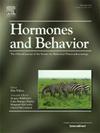在一夫一妻制的草原田鼠中,衰老会对配对结合产生性别依赖性影响,并增加催产素分泌神经元的数量。
IF 2.5
3区 医学
Q2 BEHAVIORAL SCIENCES
引用次数: 0
摘要
配对关系能有效调节健康,这在面临衰老的不利影响时变得尤为重要。为了研究衰老对关系形成和对损失的反应的影响,我们研究了天真的 6 个月、12 个月和 18 个月雌雄草原田鼠的行为。我们发现,年龄较大的雄性田鼠(18 个月大)比年龄较小的田鼠更快地结合在一起,而年龄相仿的雌性田鼠则会增加伴侣引导的附属行为。为了证明结合行为的性别差异,我们发现雄性田鼠更有可能同时对伴侣和陌生人进行采样,而雌性田鼠则更有可能在测试的最初 20 分钟内表现出伴侣偏好。我们还发现,所有年龄段的雄性田鼠在与伴侣分离四周后仍表现出持久的结合行为,而雌性田鼠则表现出伴侣导向的隶属关系的整体下降,包括12个月雌性田鼠对伴侣偏好的侵蚀。最后,我们发现,18月龄时,下丘脑室旁的催产素细胞数量增加了,但血管加压素细胞的数量没有增加。这些结果使草原田鼠成为研究正常和异常衰老对配对关系影响的新型模型。本文章由计算机程序翻译,如有差异,请以英文原文为准。
Aging leads to sex-dependent effects on pair bonding and increased number of oxytocin-producing neurons in monogamous prairie voles
Pair bonds powerfully modulate health, which becomes particularly important when facing the detrimental effects of aging. To examine the impact of aging on relationship formation and response to loss, we examined behavior in naive 6-, 12-, and 18-month male and female prairie voles, a monogamous species that forms mating-based pair bonds. We found that older males (18-months) bonded quicker than younger voles, while similarly aged female voles increased partner directed affiliative behaviors. Supporting sex differences in bonding behaviors, we found that males were more likely to sample both partner and stranger voles while females were more likely to display partner preference during the initial 20 min of the test. We also found that male voles of all ages show enduring bonding behavior despite four weeks of partner separation while females show an overall decrease in partner-directed affiliation, including an erosion of partner preference in 12-month females. Finally, we found that the number of oxytocin, but not vasopressin, cells in the paraventricular hypothalamus increased at 18 months of age. These results establish prairie voles as a novel model to study the effects of normal and abnormal aging on pair bonding.
求助全文
通过发布文献求助,成功后即可免费获取论文全文。
去求助
来源期刊

Hormones and Behavior
医学-行为科学
CiteScore
6.70
自引率
8.60%
发文量
139
审稿时长
91 days
期刊介绍:
Hormones and Behavior publishes original research articles, reviews and special issues concerning hormone-brain-behavior relationships, broadly defined. The journal''s scope ranges from laboratory and field studies concerning neuroendocrine as well as endocrine mechanisms controlling the development or adult expression of behavior to studies concerning the environmental control and evolutionary significance of hormone-behavior relationships. The journal welcomes studies conducted on species ranging from invertebrates to mammals, including humans.
 求助内容:
求助内容: 应助结果提醒方式:
应助结果提醒方式:


